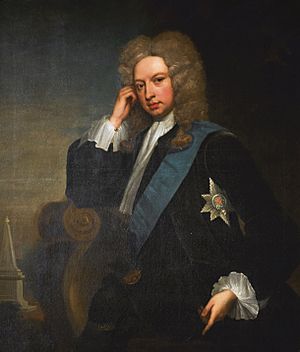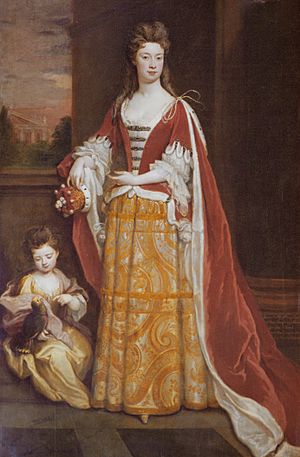Henry Grey, 1st Duke of Kent facts for kids
Quick facts for kids
The Duke of Kent
|
|
|---|---|

Portrait by Charles Jervas
|
|
| Lord Chamberlain | |
| In office 1704–1710 |
|
| Preceded by | The Earl of Jersey |
| Succeeded by | The Duke of Shrewsbury |
| Lord Steward of the Household | |
| In office 1716–1718 |
|
| Preceded by | The Duke of Devonshire |
| Succeeded by | The Duke of Argyll |
| Lord Privy Seal | |
| In office 1719–1720 |
|
| Preceded by | The Duke of Kingston |
| Succeeded by | The Duke of Kingston |
Henry Grey, the 1st Duke of Kent (born 1671, died 1740), was an important British politician and a member of the royal court. He held several high-ranking positions during his life. Sadly, none of his sons lived longer than him. Because of this, his special title of Duke ended when he passed away. He built a grand house called Wrest Park in Bedfordshire. While the house is gone, parts of his beautiful garden are still there today.
Contents
Henry Grey's Family Life
Henry Grey was the son of Anthony Grey, who was the 11th Earl of Kent. His mother was Mary Grey, the 1st Baroness Lucas of Crudwell. In 1702, he became the 12th Earl of Kent after his father died. Earlier that same year, he also became the 2nd Baron Lucas after his mother passed away.
He was also the grandfather of Henry Cavendish, a very famous English scientist. Henry Cavendish was known for his work in chemistry and physics in the late 1700s.
Henry Grey's Political Career
Henry Grey became a member of the House of Lords, which is part of the British Parliament. In 1704, he was made Lord Chamberlain and a Privy Councillor. These were important roles in the government and at the royal court.
He traded his position as Lord Chamberlain for a higher title, becoming a Duke in 1710. After this, he held other important but less central roles. He served as a Gentleman of the Bedchamber and Constable of Windsor Castle. From 1716 to 1718, he was the Lord Steward of the Household. He also served as Lord Keeper of the Privy Seal from 1719 to 1720. He was one of the Lords Justices who helped govern Britain when King George I was away.
In 1719, Henry Grey was a main supporter of the Royal Academy of Music. This group helped put on baroque opera shows. When he was 68 years old, he helped create London's Foundling Hospital. This was Britain's first home for abandoned children.
Titles and Honors of Henry Grey
Henry Grey inherited the title of 12th Earl of Kent in 1702. He also became the 2nd Baron Lucas in the same year.
He received many new titles during his life. In 1706, he was made Marquess of Kent, Earl of Harold, and Viscount Goderich. In 1710, he became the Duke of Kent. This was a special honor given to him when he stepped down from his role as Lord Chamberlain. In 1712, he was made a Knight of the Garter, which is a very high honor.
Sadly, his son George Grey, Earl of Harold, died in 1733. This meant Henry Grey had no male heir to inherit his main titles. So, in 1740, he was given the new title of Marquess Grey. This title was special because it could be passed down to his granddaughter, Lady Jemima Campbell, and her male children. She also inherited the Barony of Lucas. All of Henry Grey's other titles ended when he died.
Marriages and Children
Henry Grey married his first wife, Jemima Crew, in 1694. She passed away in 1728. Jemima was the daughter of Thomas Crew, the 2nd Baron Crew. Henry and Jemima had at least six children together:
- Anthony Grey, Earl of Harold (died 1723). He married Lady Mary Tufton.
- Henry Grey (born around 1696, died 1717).
- Amabel Grey (died 1726). She married John Campbell, the 3rd Earl of Breadalbane and Holland.
- Jemima Grey (born around 1699, died 1731). She married John Ashburnham, the 1st Earl of Ashburnham.
- Anne Grey (died 1733). She married Lord Charles Cavendish.
- Mary Grey. She married David Gregory.
Henry married his second wife, Sophia Bentinck, on March 24, 1729. She was the daughter of William Bentinck, the 1st Earl of Portland. Henry and Sophia had two children:
- George Grey, Earl of Harold (born around 1732, died 1733).
- Anne Sophia Grey (died 1780). She married John Egerton, who was a Bishop of Durham.


